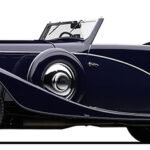If you’ve been reading car magazines for as long as I have, you’re likely familiar with “Popular Hot Rodding” magazine’s Project X.
Project X is a ’57 Chevrolet 2-dr post — and not just any ’57, but one with years of magazine use under its belt, starting in 1965 and running clear through to today. It’s had countless engine and transmission configurations over the years, has been both fuel-injected and carbureted, supercharged and naturally aspirated, all in the name of showing people the right way to do things in terms of power. It was even featured in the 1980 film, “Hollywood Knights.”
And now it’s getting an electric heart transplant.

For SEMA 2021, which takes place in Las Vegas this week, Project X has gone under the knife again, this time at NHRA shop Cagnazzi Racing in Mooresville, NC. Powering this newest version of X is a 340-hp electric motor and 400-volt proof-of-concept lithium-ion battery pack that stores 30 kWh of energy. The idea here is to utilize GM’s eCrate Connect and Cruise concept in a recognizable and high-profile way, to show what’s possible when the best of modern tech is tuned for performance applications.
“The reinvention of Project X is a reminder that our vision for a world with zero emissions includes classics like the Tri-Five Chevys,” said Prashant Ahire, eCrate regional chief engineer. “As General Motors rolls out its trailblazing EV technology, Chevrolet Performance plans to offer EV propulsion solutions for enthusiasts looking to modernize their project cars.”

“We are racers and hot rodders, with deep roots in internal-combustion racing engines,” said Vic Cagnazzi, owner of Cagnazzi Racing. “But we see this next leap into EV performance propulsion as a natural evolution for hot rodding. Our goal with this conversion was to maintain the look and integrity of the classic hot rod, while modernizing the propulsion technology.”
Meanwhile, the old-school tradition has continued over at GM.
Also just launched is a brand-new crate engine on the performance side, displacing a massive 632-ci and making a stout 1,004 horses.
The ZZ632/1000 is both the largest and the most powerful crate engine ever offered by the company. It does so with big-block similar to the one used in the ZZ572, but with a casting that’s a little beefier to accommodate a larger bore for the 632’s larger pistons. The 632 also gains a 0.375-inch longer stroke than the 572, which also required block mods for clearance. And yet, it should be an easy bolt-in anywhere a 396, 427 or 454 once lived.

Helping to make the power here is a set of unique “RS-X” cylinder heads that share as much with the later LS engines as they do with the Mark IV big-blocks of years past. These heads have CNC equal-length intake and exhaust ports for excellent air/fuel distribution and consistent power from cylinder to cylinder.
Long intake runners, port-injection and what appears to be a modern-style cam sensor are also all here — the last part suggesting distributorless ignition and exceptional tuning ability, just like with the LS and LT engines.

GM says you can spin it to 7,000 rpm — and they also say that it’s solely designed for competition use. Installing it in an emissions-controlled vehicle used on the street is “likely to violate U.S., Canadian and state and provincial laws and regulations related to motor vehicle emissions.”
You don’t say. Better keep it in a dragster or something pre-’67.
Each of these two developments paint interesting pictures of the future of performance, but I think the real story here is in the debut of them together at SEMA 2021. Clearly, GM is looking both at its past and its future when it comes to the automotive aftermarket, and they’re doing a lot to serve two different types of client in innovative ways.
What does this really mean for the average consumer? Someone who might not want an EV swap or 1,000 horses? Well, I think the main takeaway here is that the best technology available continues to make its way into the specialty car market, and the tech itself has evolved to levels that seemed unlikely even just a few short years back. That is very, very good news for our evolving hobby.
The modern trends, from EV power to extremely potent and distilled gasoline engine innovation, are reaching out to touch the old car world. As far as I’m concerned, that can only be considered a good thing, regardless of how you like your performance — silent or otherwise.













More Stories
The Future of Muscle
Finding GM Gold
Snapshots from Monterey